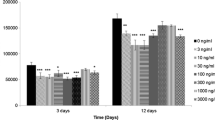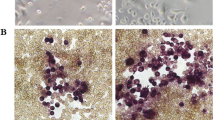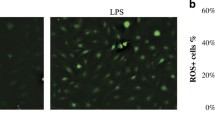Abstract
As dental precursor cells, stem cells from the apical papilla (SCAP) are capable of forming roots and undergoing apexogenesis, which are impaired upon exposure to bacterial infection. Porphyromonas gingivalis is a common Gram-negative bacterium that is involved in pulpal and periapical infection. The purpose of this study was to investigate the effects of P. gingivalis lipopolysaccharide (LPS) on the Wnt/β-catenin and p38 mitogen-activated protein kinase (MAPK) signalling pathways in SCAP. As indicated by the IL-1β and TNF-α mRNA levels, P. gingivalis LPS induced the expression of pro-inflammatory cytokines in a dose-dependent manner. In addition, activation of the p38 MAPK and Wnt/β-catenin pathways was confirmed by the augmentation of phospho-p38 and β-catenin protein expression and increased expression of c-myc and cyclin D1 mRNA. Despite no significant increase in β-catenin mRNA expression, increased phosphorylation of glycogen synthase kinase (GSK)-3β suggested that GSK-3β was responsible for the accumulation of β-catenin in the cytoplasm and translocation to the nucleus. Previous studies have shown that GSK-3β plays a critical role in crosstalk between the Wnt/β-catenin and p38 MAPK pathways. In the present study, we showed that the level of p38 phosphorylation decreased upon pretreatment with a p38 MAPK inhibitor for 1 h before stimulating SCAP with 10 μg/ml P. gingivalis LPS. However, the levels of GSK-3β and β-catenin phosphorylation in the cytoplasm and nucleus were not significantly altered. Our results suggest that the p38 MAPK and canonical Wnt/β-catenin signalling pathways are activated by P. gingivalis LPS in SCAP, but we have no evidence that p38 MAPK is upstream of GSK-3β in the Wnt/β-catenin signalling pathway.




Similar content being viewed by others
REFERENCES
Sonoyama, W., Y. Liu, D. Fang, T. Yamaza, B.M. Seo, C. Zhang, et al. 2006. Mesenchymal stem cell-mediated functional tooth regeneration in swine. PloS One 1: e79.
Huang, G.T., S. Gronthos, and S. Shi. 2009. Mesenchymal stem cells derived from dental tissues vs. those from other sources: Their biology and role in regenerative medicine. Journal of Dental Research 88(9): 792–806.
Darveau, R.P., T.T. Pham, K. Lemley, R.A. Reife, B.W. Bainbridge, S.R. Coats, et al. 2004. Porphyromonas gingivalis lipopolysaccharide contains multiple lipid A species that functionally interact with both toll-like receptors 2 and 4. Infection and Immunity 72(9): 5041–5051.
Siqueira Jr., J.F., I.N. Rocas, and M.G. Silva. 2008. Prevalence and clonal analysis of Porphyromonas gingivalis in primary endodontic infections. Journal of Endodontics 34(11): 1332–1336.
Bainbridge, B.W., and R.P. Darveau. 2001. Porphyromonas gingivalis lipopolysaccharide: An unusual pattern recognition receptor ligand for the innate host defense system. Acta Odontologica Scandinavica 59(3): 131–138.
Coil, J., E. Tam, and J.D. Waterfield. 2004. Proinflammatory cytokine profiles in pulp fibroblasts stimulated with lipopolysaccharide and methyl mercaptan. Journal of Endodontics 30(2): 88–91.
Liu, R., T. Desta, M. Raptis, R.P. Darveau, and D.T. Graves. 2008. P. gingivalis and E. coli lipopolysaccharides exhibit different systemic but similar local induction of inflammatory markers. The Journal of Periodontology 79(7): 1241–1247.
Nomiyama, K., C. Kitamura, T. Tsujisawa, M. Nagayoshi, T. Morotomi, M. Terashita, et al. 2007. Effects of lipopolysaccharide on newly established rat dental pulp-derived cell line with odontoblastic properties. Journal of Endodontics 33(10): 1187–1191.
Trindade, S.C., T. Olczak, I.S. Gomes-Filho, L.F. Moura-Costa, V.L. Vale, M. Galdino-Neto, et al. 2011. Porphyromonas gingivalis antigens differently participate in the proliferation and cell death of human PBMC. Archives of Oral Biology 57(3): 314–320.
Diya, Z., C. Lili, L. Shenglai, G. Zhiyuan, and Y. Jie. 2008. Lipopolysaccharide (LPS) of Porphyromonas gingivalis induces IL-1beta, TNF-alpha and IL-6 production by THP-1 cells in a way different from that of Escherichia coli LPS. Innate Immunity 14(2): 99–107.
Siqueira Jr., J.F., I.N. Rocas, J.C. Oliveira, and K.R. Santos. 2001. Molecular detection of black-pigmented bacteria in infections of endodontic origin. Journal of Endodontics 27(9): 563–566.
Herlaar, E., and Z. Brown. 1999. p38 MAPK signalling cascades in inflammatory disease. Molecular Medicine Today 5(10): 439–447.
Diya, Z., C. Lili, L. Shenglai, G. Zhiyuan, and Y. Jie. 2008. Lipopolysaccharide (LPS) of Porphyromonas gingivalis induces IL-1β, TNF-α and IL-6 production by THP-1 cells in a way different from that of Escherichia coli LPS. Innate Immunity 14(2): 99–107.
Darveau, R.P., S. Arbabi, I. Garcia, B. Bainbridge, and R.V. Maier. 2002. Porphyromonas gingivalis lipopolysaccharide is both agonist and antagonist for p38 mitogen-activated protein kinase activation. Infection and Immunity 70(4): 1867–1873.
Miller JR. 2002. The Wnts. Genome Biol 3(1): REVIEWS3001.
Liu, F., and S.E. Millar. 2010. Wnt/beta-catenin signaling in oral tissue development and disease. Journal of Dental Research 89(4): 318–330.
Christman 2nd, M.A., D.J. Goetz, E. Dickerson, K.D. McCall, C.J. Lewis, F. Benencia, et al. 2008. Wnt5a is expressed in murine and human atherosclerotic lesions. American Journal of Physiology - Heart and Circulatory Physiology 294(6): H2864–H2870.
Bergenfelz, C., C. Medrek, E. Ekström, K. Jirström, H. Janols, M. Wullt, et al. 2012. Wnt5a Induces a tolerogenic phenotype of macrophages in sepsis and breast cancer patients. The Journal of Immunology 188(11): 5448–5458.
Lee, H., S. Bae, B.W. Choi, and Y. Yoon. 2012. WNT/β-catenin pathway is modulated in asthma patients and LPS-stimulated RAW264.7 macrophage cell line. Immunopharmacology and Immunotoxicology 34(1): 56–65.
George, S.J. 2008. Wnt pathway: A new role in regulation of inflammation. Arteriosclerosis, Thrombosis, and Vascular Biology 28(3): 400–402.
Duan, Y., A.P. Liao, S. Kuppireddi, Z. Ye, M.J. Ciancio, and J. Sun. 2007. beta-Catenin activity negatively regulates bacteria-induced inflammation. Laboratory Investigation 87(6): 613–624.
Pereira, C.P., E.B. Bachli, and G. Schoedon. 2009. The wnt pathway: A macrophage effector molecule that triggers inflammation. Current Atherosclerosis Reports 11(3): 236–242.
Bikkavilli, R.K., M.E. Feigin, and C.C. Malbon. 2008. p38 mitogen-activated protein kinase regulates canonical Wnt-beta-catenin signaling by inactivation of GSK3beta. Journal of Cell Science 121(Pt 21): 3598–3607.
Caverzasio, J., and D. Manen. 2007. Essential role of Wnt3a-mediated activation of mitogen-activated protein kinase p38 for the stimulation of alkaline phosphatase activity and matrix mineralization in C3H10T1/2 mesenchymal cells. Endocrinology 148(11): 5323–5330.
Thornton, T.M., G. Pedraza-Alva, B. Deng, C.D. Wood, A. Aronshtam, J.L. Clements, et al. 2008. Phosphorylation by p38 MAPK as an alternative pathway for GSK3beta inactivation. Science 320(5876): 667–670.
Wang, J., B. Liu, S. Gu, and J. Liang. 2012. Effects of Wnt/beta-catenin signalling on proliferation and differentiation of apical papilla stem cells. Cell Proliferation 45(2): 121–131.
Gehrke, I., R.K. Gandhirajan, and K.-A. Kreuzer. 2009. Targeting the WNT/β-catenin/TCF/LEF1 axis in solid and haematological cancers: Multiplicity of therapeutic options. European Journal of Cancer 45(16): 2759–2767.
Siqueira Jr., J.F., and I.N. Rocas. 2007. Bacterial pathogenesis and mediators in apical periodontitis. Brazilian Dental Journal 18(4): 267–280.
Nair, P.N. 2006. On the causes of persistent apical periodontitis: A review. International Endodontic Journal 39(4): 249–281.
Nair, P.N.R. 2007. Pathobiology of apical periodontitis. In Essential endodontology: Prevention and treatment of apical periodontitis, 2nd ed, ed. T.P.F. Dag Orstavik, 81–135. Oxford: Blackwell Munksgaard Ltd.
Baumgartner, J.C., B.J. Watkins, K.S. Bae, and T. Xia. 1999. Association of black-pigmented bacteria with endodontic infections. Journal of Endodontics 25(6): 413–415.
Bletsa, A., E. Berggreen, I. Fristad, O. Tenstad, and H. Wiig. 2006. Cytokine signalling in rat pulp interstitial fluid and transcapillary fluid exchange during lipopolysaccharide-induced acute inflammation. The Journal of Physiology 573(Pt 1): 225–236.
Tani-Ishii, N., C.Y. Wang, and P. Stashenko. 1995. Immunolocalization of bone-resorptive cytokines in rat pulp and periapical lesions following surgical pulp exposure. Oral Microbiology and Immunology 10(4): 213–219.
Miyauchi, M., S. Sato, S. Kitagawa, M. Hiraoka, Y. Kudo, I. Ogawa, et al. 2001. Cytokine expression in rat molar gingival periodontal tissues after topical application of lipopolysaccharide. Histochemistry and Cell Biology 116(1): 57–62.
Biton, J., M.C. Boissier, and N. Bessis. 2011. TNFalpha: Activator or inhibitor of regulatory T cells? Joint, Bone, Spine 79(2): 119–123.
De Boer, J., H.J. Wang, and C. Van Blitterswijk. 2004. Effects of Wnt signaling on proliferation and differentiation of human mesenchymal stem cells. Tissue Engineering 10(3–4): 393–401.
Neth, P., M. Ciccarella, V. Egea, J. Hoelters, M. Jochum, and C. Ries. 2006. Wnt signaling regulates the invasion capacity of human mesenchymal stem cells. Stem Cells 24(8): 1892–1903.
Liu, N., S. Shi, M. Deng, L. Tang, G. Zhang, N. Liu, et al. 2011. High levels of β-catenin signaling reduce osteogenic differentiation of stem cells in inflammatory microenvironments through inhibition of the noncanonical Wnt pathway. Journal of Bone and Mineral Research 26(9): 2082–2095.
Mishra, P., S. Senthivinayagam, A. Rana, and B. Rana. 2010. Glycogen synthase kinase-3beta regulates snail and beta-catenin during gastrin-induced migration of gastric cancer cells. Journal of Molecular Signaling 5: 9.
Jope, R.S., C.J. Yuskaitis, and E. Beurel. 2007. Glycogen synthase kinase-3 (GSK3): Inflammation, diseases, and therapeutics. Neurochemical Research 32(4–5): 577–595.
Bikkavilli, R.K., M.E. Feigin, and C.C. Malbon. 2008. Gαo mediates WNT-JNK signaling through dishevelled 1 and 3, RhoA family members, and MEKK 1 and 4 in mammalian cells. Journal of Cell Science 121(2): 234–245.
Zhang, M., W. Jin, X. Zhou, J. Yu, A.J. Lee, and S.C. Sun. 2009. Deregulation of Tpl2 and NF-kappaB signaling and induction of macrophage apoptosis by the anti-depressant drug lithium. Cellular Signalling 21(4): 559–566.
Armstrong, L., O. Hughes, S. Yung, L. Hyslop, R. Stewart, I. Wappler, et al. 2006. The role of PI3K/AKT, MAPK/ERK and NFκβ signalling in the maintenance of human embryonic stem cell pluripotency and viability highlighted by transcriptional profiling and functional analysis. Human Molecular Genetics 15(11): 1894–1913.
Guha, M., and N. Mackman. 2002. The phosphatidylinositol 3-kinase-Akt pathway limits lipopolysaccharide activation of signaling pathways and expression of inflammatory mediators in human monocytic cells. The Journal of Biological Chemistry 277(35): 32124–32132.
Fukao, T., and S. Koyasu. 2003. PI3K and negative regulation of TLR signaling. Trends in Immunology 24(7): 358–363.
ACKNOWLEDGMENTS
This work was supported by grant 81271133 from the National Natural Science Foundation of China.
Author information
Authors and Affiliations
Corresponding author
Rights and permissions
About this article
Cite this article
Wang, J., Dai, J., Liu, B. et al. Porphyromonas gingivalis Lipopolysaccharide Activates Canonical Wnt/β-Catenin and p38 MAPK Signalling in Stem Cells from the Apical Papilla. Inflammation 36, 1393–1402 (2013). https://doi.org/10.1007/s10753-013-9679-y
Published:
Issue Date:
DOI: https://doi.org/10.1007/s10753-013-9679-y




